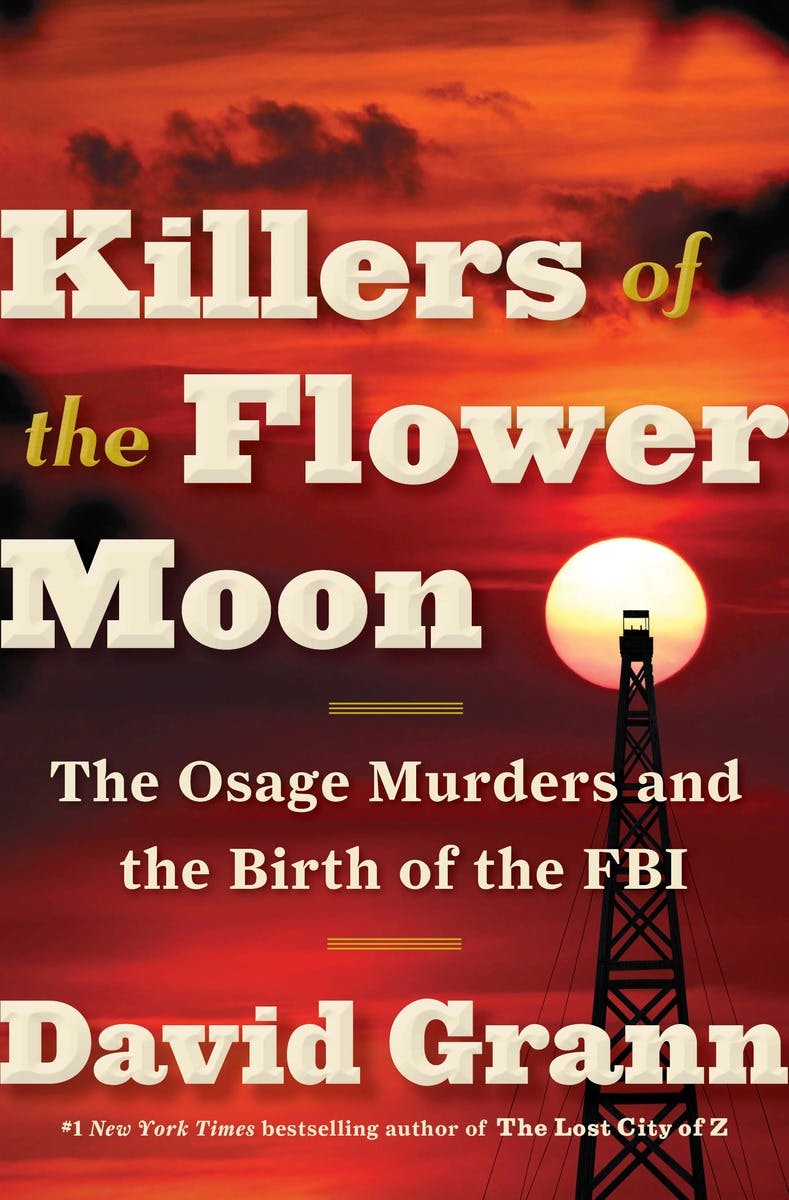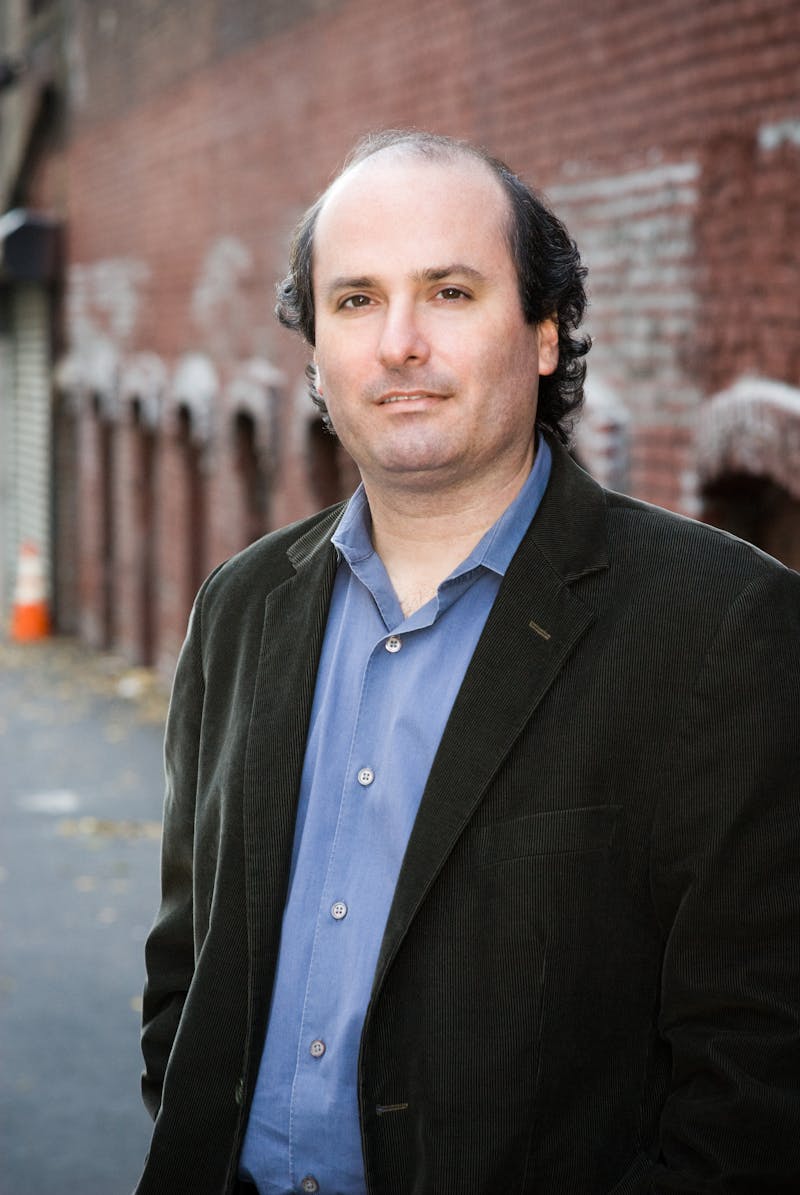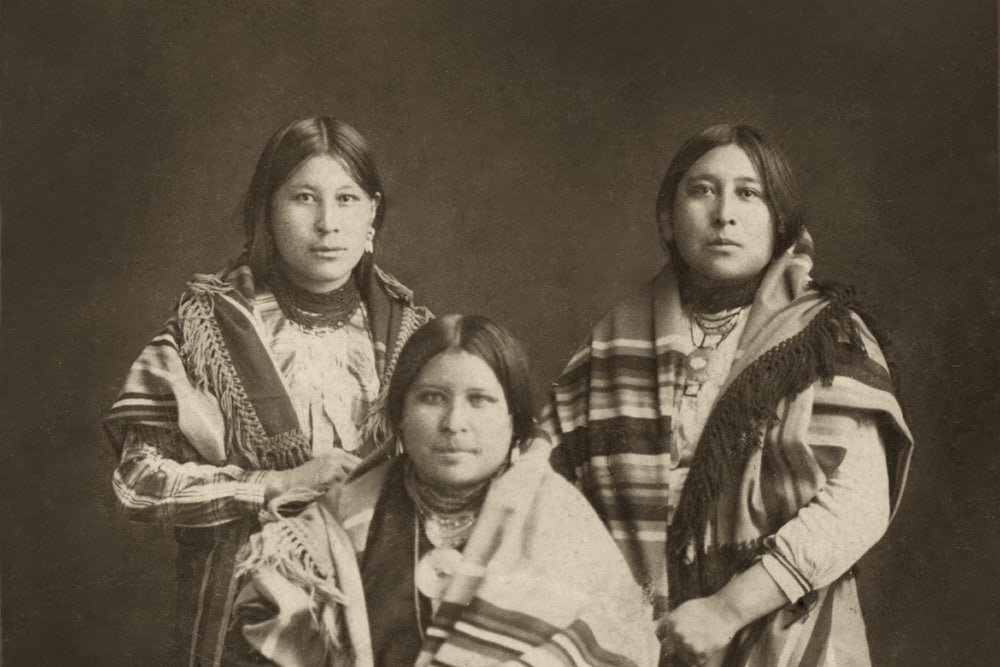In 1926, a cattle rustler and
bootlegger named John Ramsey was convicted for his role in the execution-style murder
of Henry Roan, a member of the Osage Nation from Oklahoma. Ramsey admitted to his part in the killing, and named his accomplices, under interrogation by FBI
agents, saying, “white people in Oklahoma thought no more of killing an Indian
[now] than they did in 1724.”
Killers of the Flower Moon: The Osage Murders and the Birth of the FBI, by David Grann, vividly depicts that brutal mindset, recounting one of the most heinous episodes of violence against Native Americans in modern U.S. history.
In the early 1900s, the Osage were among the wealthiest people in the United States, after a large oil reservoir was discovered beneath the barren Oklahoma scrubland they had been driven to by white settlers and the federal government. Then tragedy: a string of murders, each following close on the heels of the next, as a bloody plot to separate the Osage from their money and land unfolded.
Grann tells the story of these murders, the conspirators, and the new breed of lawmen from the FBI who hunted them down. He also reveals a far worse scheme, one that encompasses America’s institutional racism and violence, and the exploitation of Native Americans.

I spoke with Grann in the New Republic offices in New York to learn more about the book, what drives him to report, and the limitations of writing history. The interview has been edited and condensed for clarity.
The first sections of Killers of the Flower Moon are an account of what is already known: How the FBI investigated a series of murders and punished the perpetrators. But by the end, we are presented with previously unknown, and far more widespread, transgressions against the Osage, more murders, unceasing financial abuse. Let’s say you had never discovered any of that. Would it have been enough for you to just have told this rich history of the murders?
I think so. I think it was enough to know that there were more than 24 murders targeting Osage victims because of their money; that it became one of the FBI’s first major homicide cases; that the crimes were so intimate and involved a kind of calculation and a baroque level of deception that’s kind of unfathomable. Little was known about many details of the cases. And so, yes, I think there would have been enough to embark on a book. But one of the things about reporting and research is you really don’t know what you will find. You don’t really know all of the dimensions of a story. And when those dimensions opened up for me, I learned that there was a deeper, darker conspiracy that is just fairly breathtaking. To some extent, I was trying to reclaim history. These were stories and voices that were lost, in the sense that they were not more broadly documented. And so I was trying to give these people back their voices. That became for me the ultimate challenge and the most important thing. Obviously I’m limited by what records exist, and I wish I could go deeper. There are so many unsolved cases. We live with the horror that we don’t know.
The federal government’s sanctioning of the
financial mistreatment of the Osage was particularly appalling.
This is the 1920s. The Osage were the wealthiest people per capita in the world at the time, and the United States government somehow decided that because these were American Indians, they couldn’t handle their own money and they were going to appoint white guardians. This was incredibly racist. In fact, the guardianship was often based on the amount of Osage blood: If you were a full-blood Osage, then you were deemed incompetent and given a guardian. Sometimes there would be a chief who’d led a great nation and who has a million dollars in the bank, and he had to have somebody tell him what toothpaste he could buy or if he could get a car, or what kind of car, or where he had to buy it. That in itself would’ve been outrageous, but on top of that, it was just a system for graft and exploitation. These guardians made a fortune on what became known as the “Indian Business.” It was literally a business. It was a massive criminal enterprise, and you have to understand the levels of money, I mean we’re not talking about sticking up a local store. In 1923, I think the Osage Nation made the equivalent of more than $400 million today, in one year.
Despite the horror at its core, this book is such a pleasure to read! Did you feel any concern that the great yarn elements of it—the cowboys and outlaws and Indians and gangsters—would detract from this sweeping morality epic?
It’s a good question. This is a story that has elements of mystery, it’s a story that has elements of intrigue, it is a story that has unexpected twists and turns. That is part of the story, and you can’t cut them out. The characters happen to be—especially William Hale, the mastermind behind the 24 murders—the most biblical, Cormac McCarthy-like characters that I’ve ever encountered in nonfiction, and that’s who they were and you need to render them.
I’ve always been a big believer that you can use the elements of storytelling to bring the reader along, and to hopefully illuminate a lot of the important things. It’s a challenge, but it’s something I kind of believe in. This is an investigative piece, and it’s got elements of a crime story, and you have investigators doing sleuthing—it has these elements, they are part of the story, they’re not imposed on it. Hopefully, I can use that form so that people will read the book and be brought along and discover something hopefully more profound, which to me, is the grave racial injustice, one of the worst and most sinister crimes in modern American history that I know of.
In many ways justice was never really done. Most of the worst criminals got off easy or were never punished. There’s not even conclusive proof that many suspected murders took place. I’m interested in how the disappearances of these lives connects to the disappearance of this historical moment for the Osage, and the broader history of the country—the frontier, open spaces, the era of American mobility. Were you thinking of those themes?
It’s interesting, you don’t always know what a book is about. You know the broad outlines and certain elements, but it’s only as you dig deeper into the story, into the research, that you start to get a sense of its larger themes. You realize this is a story about racial injustice, it’s about deep exploitation, it’s about this original sin from which our country was born, which we don’t often want to talk about and look at. You also realize that there is a theme about the birth of law enforcement.
Another theme that became apparent to me in time was the elusiveness of history. I often felt like I was chasing ghosts. One of the reasons I structured the book in three chronicles, each from a different perspective, was to hopefully deepen this theme. So the first chronicle is largely told from the perspective of the Osage woman Mollie Burkhart who’s a prime target of the conspiracy. You get to see how she experienced history as it’s really unfolding.
Too often, historians and reporters write with a power of hindsight and therefore they have a certain arrogance of God. They ignore what it’s like to muddle through life, especially when you’re in the middle of a conspiracy and you can’t see all elements of the truth, and you’re trapped. It’s not that you’re an unreliable narrator, it’s just that you have limited information of people who are deceiving you.
Mollie Burkhart was in danger.
Yeah, and she doesn’t know it. The second chronicle is told through the FBI investigator, Tom White, who has access to a different set of facts and another part of the story. He’s very methodical, does a lot of great detective work, but he also has limitations to what he can know and learn. The third and final chronicle is told from my perspective in the present. I can fill in some of the gaps in the historical record by gathering new information. And yet what became deeply apparent to me while researching the book was that I’m trapped in my own limitations. It’s almost a century later and trails of evidence have washed away, I can’t interrogate the dead, witnesses are gone. So I put together clues and circumstantial evidence, and in some cases go even further and pinpoint an apparent killer. But I’m chasing ghosts, too. There’s an elusive quality to history, and I wanted that to become a part of the book. The Osage have this lovely phrase, ‘Travelers in the Mist.” It was the term for part of an Osage clan that would take the lead whenever the tribe was venturing into unfamiliar realms. And, in a way, we are all travelers in the mist.
The challenge is that as writers we sometimes want to ignore this murkiness or we want to write around it. I thought, No, no! I want that to be part of the story. In fact, I want it to be a central theme of the story because this is the reality. And this gets at much a deeper horror, which is the unknowability of history. There are killers who slipped away, and not even history can bring them to account. What we know is horrible and what we don’t know is even more horrible. I came to understand this dimension of the book only over time.
That unknowability is ultimately what one takes away from the book.
In reporting this story, I dealt a lot with documents, and that can be antiseptic. But for me, one of the most moving things was meeting the descendants of the people I was writing about. And when you have descendants who say to you, ‘Oh, you know, I had this relative who we’ve always suspected was murdered, and here I have I few documents that we’ve gathered,’ and you realize that all these people have been living with these mysteries and unresolved questions, you just start to realize the extent to which people are haunted by this history and that it’s still alive. It’s still alive. These crimes did not take place during the colonial era. They took place in the early twentieth century—less than a hundred years ago.
The Lost City of Z, your previous book, is about the mysterious death of the British explorer Perry Fawcett. But it was animated not just by Fawcett, but by the allure of uncharted, alien places. Killers of the Flower Moon is a purely American tale. It explores the national character and temperament, for good and ill. How aware of that were you?
For me, this book was really in many ways about the birth of this country, a modern country. The individuals involved in it, I came to understand them as transitional figures. Mollie Burkhart is somebody who grew up in a lodge in the 1880s, speaking Osage, observing Osage practices, and she’s uprooted from her home, forced to go to a Catholic school, and within about a 30-year span she’s living in a mansion, she has a white husband, she’s speaking English, she has white chauffeurs. So, she’s basically straddling two centuries and two civilizations.

Tom White is a transitional figure, too. He grew up in a log cabin in Texas, on the frontier, when frontier justice was meted out with a gun. By the time of the Osage cases, he’s learning about fingerprints and handwriting analysis, he’s wearing a suit, he has to file paperwork, he’s becoming a bureaucrat in some ways, a professional. So he’s also straddling these centuries, straddling these forces that are making this modern country.
So in a way, in getting to know the particulars
of these people the larger themes become apparent. And of course,
the villain, one of the villains, William Hale, is this protean American figure. And of course, the villain, one of
the villains, William Hale, is this protean American figure. He shows up in
Osage territory wearing rags and carrying a Bible—a man with no discernable
past. He begins to reinvent himself,
becoming a cattle baron who is known as the King of the Osage Hills. Yet his
transformation conceals a trail of blood and murder.
I’m going to shift gears a little bit and ask you one that’s sort of a curveball. Your classic 1997 New Republic story, “Robespierre of the Right,” profiled conservative gadfly Paul Weyrich, founder of the Heritage foundation. Our house attorney recently spoke to the editorial staff about libel in the Trump era. He mentioned that you and the New Republic were sued for libel over that story, and that eventually you prevailed. Would you have done that particular story in the way that you did it, today, in the era of Donald Trump and Gawker? Were there libel concerns on this book? You don’t actually accuse anyone of murder, but there are people who are related to the people you’re accusing of murder.
With Weyrich, it was a pretty frivolous suit. I think they sued the cartoonist...
They didn’t like the illustration.
Yeah! And the attorney was Larry Klayman, who is ludicrously litigious. [Klayman is a politically conservative lawyer, known for his provocative lawsuits. Most recently, in 2016, he sued the Republican National Committee over the apportionment of Trump delegates from Florida. The case was dismissed.]
To answer your question, we have an obligation to the truth. It’s our most important obligation when we do these things. I never want to make people upset, but sometimes we may. When I interview people, I try to make it clear that our obligation is to what we uncover and to telling that story and to presenting it fairly and making sure everyone has a say. If we start to bow down, and we don’t do that, then it really is the end of truth or the abilities to ferret it out responsibly. On the other hand, I am fully aware of the challenges in this environment and to pretend that they don’t exist or that it’s not daunting, you’d have to be naïve. But I still think you have to come back to that obligation, because once you lose that then you’ve already folded, you’ve already given up the game, and then you might as well pack your bag.
I always like to close an interview by asking what should I have asked but didn’t. What’s the thing that I was such an idiot to leave out?
I always ask that, too. You did a pretty good job. You threw me with a couple of these. I hope people will reckon with this book. It’s something I spent half a decade on and care about deeply, because of what it’s about. I’ve done a lot of stories over the years, and sometimes there are larks and they’re fun and you kind of move on. But this one has a moral import.
